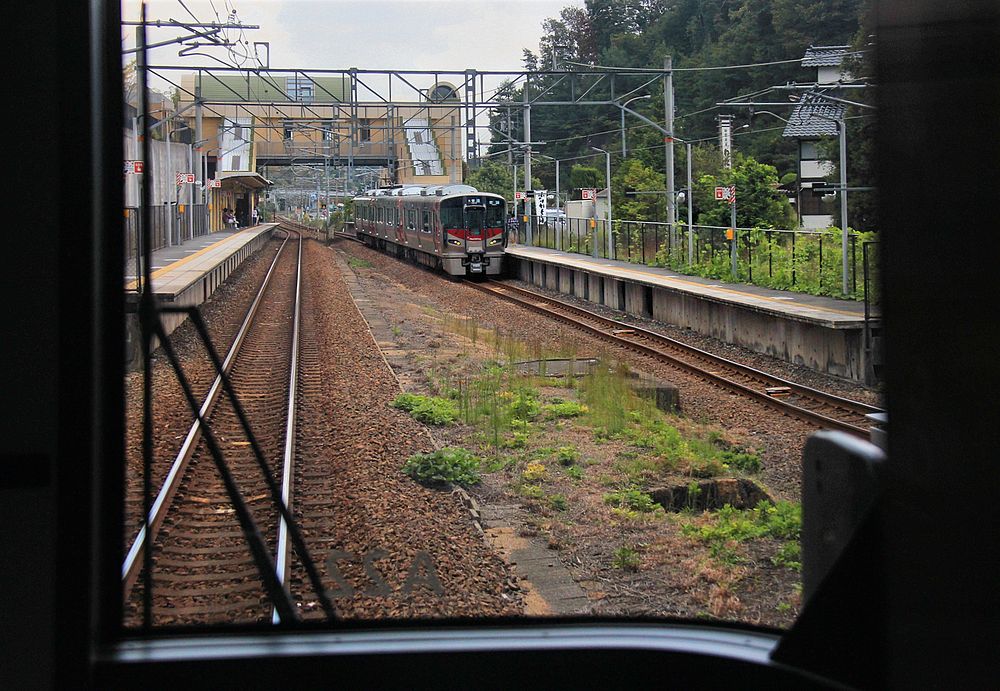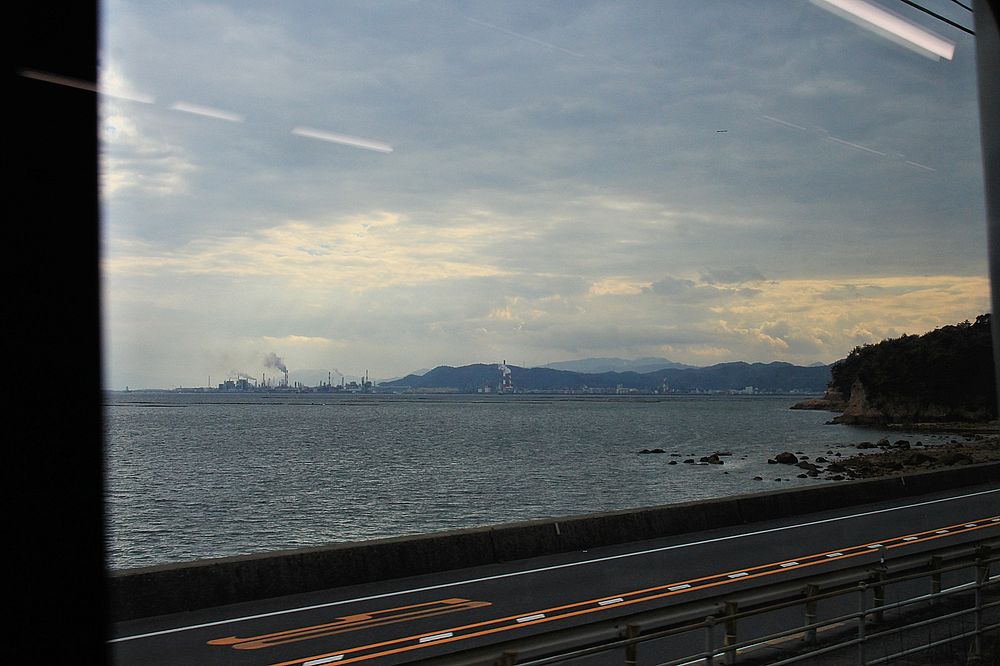San’yô Honsen (Hiroshima – Shimonoseki) 山陽本線(広島―下関)

A Hiroshima urban network train class 227 (train set 227-18 leading) crossing the river between Waki and Ôtake, just northeast of Iwakuni. (2015)

(continuation of the text "San'yô Honsen, Himeji – Hiroshima")
After leaving Hiroshima in westerly direction the train clings to the coastline of the very mountainous country and runs through suburban settlements and industrial zones as far as Iwakuni (41, 4 km from Hiroshima). On the way we also get a view of the overland Hiroshima tramway to Miyajima-guchi, from where a ferry takes one across to the island of Miyajima with its famous shrine.
At Iwakuni the Hiroshima urban network ends, and two lines continue westward. The straight line ahead to Tokuyama has steep gradients and a long tunnel, so the Sanyô main line along the coast provided more favourable conditions for fast steam express trains. Thus the principal services to the west follow the longer route along Hiroshima Bay down to Ôbatake and Yanai. From Ôbatake station we can see the imposing bridge linking the mainland with Suô Ôshima island.
After passing through Kudamatsu with Hitachi's important railway rolling stock construction factories the train arrives at Tokuyama (68, 8 km from Iwakuni) with its huge oil refinery and the vast plants of its chemical industry. From here to Shin Yamaguchi we can catch breathtaking glimpses of the Suô Straits; after Hôfu the train then passes through small agricultural communities to Shin Yamaguchi. Until 2003 Shin Yamaguchi ("New Yamaguchi", or "the Shinkansen station of Yamaguchi") was known as Ogôri but changed its name in order to attract attention to nearby Yamaguchi, the capital town of Yamaguchi Prefecture situated about 13 km up the valley.
Meandering mostly through rice fields and farm villages the one to two passenger trains per hour west of Shin Yamaguchi pass through the junctions of Ube, Onoda and Asa to reach Shimonoseki, 113, 2 km from Tokuyama. Shortly before Hatabu (about 4 km up the line from Shimonoseki) the San'in Honsen from the Japan Sea joins the San'yô Honsen for the run to the terminus. Shimonoseki is an important port city directly by the Kanmon Straits, with a good view across to Kyûshû.
Since the opening of the Kanmon Railway Tunnel in 1942 trains continue under the sea to Moji and beyond on the island of Kyûshû (Moji is 6, 3 km from Shimonoseki). Formerly important express and sleeping car trains coming from Tôkyô and Kyôto/Ôsaka had to take the Kanmon Tunnel route to reach the large cities on the island of Kyûshû. Today we can still see substantial container trains to and from Kyûshû, but since 1975 long distance passenger services are operated by the Shinkansen and through the Shinkansen's own tunnel. So the San'yô Honsen terminus at Shimonoseki now has only a local shuttle service across to Kyûshû operated by JR Kyûshû, mostly with old dual-current stock.
The first trains on the San'yô Honsen began operating as early as 1888 in the Hyôgo-Akashi-Himeji area, and in 1901 the line was complete; nationalisation came in 1906. In July 2018 the San'yô Honsen suffered severe damage by torrential rain and landslides, particularly in the Hiroshima area. Thus through freight trains had to be diverted west of Okayama via the San'in Honsen and the Yamaguchi-sen, both of which had seen no more freight services for many years. In September 2018 a fierce typhoon interrupted the line again, so that full services could not be resumed before October 13.

Hiroshima station in the early morning, with a train headed by KUHA 115-608 leaving in the direction of Iwakuni. Above, Hiroshima Shinkansen Station is brightly lit up. (2017)

From the train near Maezora, looking across to Miyajima Island. (2015)

Train set class 227 no.2 at Maezora, an outer suburb of Hiroshima to the west. (2015)

At Ônoura just east of Iwakuni a San-yo Honsen freight train headed by EF200-15 comes in from Hiroshima on the way to Shimonoseki. (2015)

View of Iwakuni from an Iwakuni to Hiroshima urban network train, near Kuba. (2015)

A Hiroshima urban network train set class 227 (no. 22) at Iwakuni station. (2015)

Along the Inland Sea near Kôjiro in a train heading towards Iwakuni. (2010)

Along Hiroshima Bay near Kôjiro, between Yanai and Iwakuni. (2010)

At Ôbatake right at the tip of the peninsula the train passes the long bridge leading across to one of the larger islands in the Inland Sea, Suô Ôshima. (2010)

View from the train between Yanai and Ôbatake. (2010)

Entering Tokuyama station. (2010)

Small villages in the inlets of the Suô Straits, near Heta, about 10 km west of Tokuyama. (2010)

From the train between Hôfu and Tonomi, on the Shin Yamaguchi - Tokuyama section. (2010)

Train set KUHA 115-110 (still in green/orange livery) at Ogôri, which is today Shin Yamaguchi. (1983)

View over Shin Yamaguchi depot and yards. We can see the elevated San'yô Shinkansen line, and a number of red diesel cars of the Yamaguchi-sen. On the right are a yellow San'yô Honsen train and a freight train running into the station. (2015)

A local train set (class 117 no.302) at Hon Yura, west of Shin Yamaguchi. (2009)

A local train headed by class 115 KUHA 115-2021 entering Hon Yura station, west of Shin Yamaguchi. In the background we can see the rugged mountain range just east of Shin Yamaguchi. (2009)

Train set class 117 no.303 leaving Hon Yura, west of Shin Yamaguchi. (2009)

A freight train headed by locomotive EF 210-169 running through Onoda station. (2015)

Rural atmosphere at Habu station. (2015)

Farm houses behind the station of Habu, between Asa and Shimonoseki. (2015)

Between Habu and Ozuki a local train from Shimonoseki to Ube Shinkawa on the Ube-sen crosses, headed by motor coach KUMOHA 105-24. (2015)

From the train nearing Chôfu, Hatabu and Shimonoseki, not far from Ozuki. (2015)

Shimonoseki station, with a class 115 train coming in. (2015)

Shimonoseki station, with a JR Kyûshû dual-current train set (Class 411/415 no.104) waiting to pass through the Kanmon tunnel to Moji and Kokura. (2015)

Between 1956 and 2005 the sleeping car train "Asakaze" ("Morning Breeze") connected Tôkyô with Hakata station in the city of Fukuoka in Kyûshû; in the last years this train only ran as far as Shimonoseki. Here it is standing behind locomotive EF66 49 at Shimonoseki. (2001)

A cabin in the sleeping car O-HA-NE 25 195. (2001)

